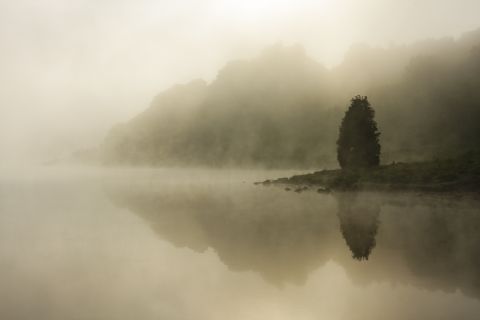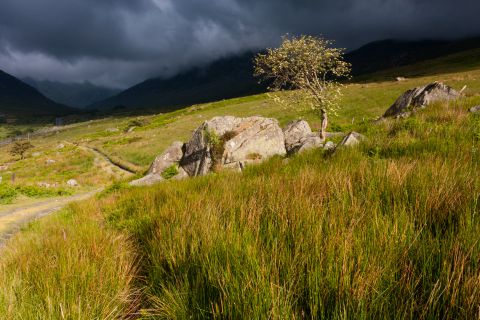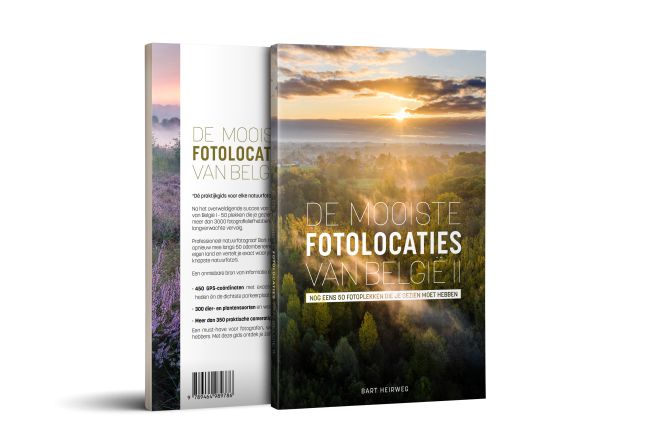Snowdonia national park

Access
Snowdonia can be reached from the North by taking the A55, from the Midlands and South England by following the A5, from the South of Wales by taking the A470 and from Ireland by first taking the ferry to Holyhead and then following the A5 towards Snowdonia. The nearest airports are Manchester and Birmingham. There is public transport in the park that takes you to the most important areas in the park.
The mountain ranges, lakes and valleys are accessible for free. In high season a small parking fee, going from £2.00 to £4.00, might be asked. These funds are used to support the park.
What to Find
Snowdonia covers a variety of landscapes and offers great opportunities for landscape photographers. For those who like the wide vistas, the numerous mountain walks offer some fantastic aerial shots. In the valleys, the beautiful mountain rivers and rock structures operate well as a foreground interest for the mountains peaks and ridges in the background, leading the viewer’s eyes into the picture. In the early morning or late evening, when it is wind still, reflections of the mountains can be photographed in the beautiful lakes.
In winter the mountains are covered with snow and certainly create a fairytale-like atmosphere.
The high mountains are surrounded by typical welsh farmland: green sloping hills, covered with white patches of sheep, surrounded by hedges and dry stone walls, while the background shows you Snowdonia’s highest mountains.
On the west side, just outside the National Park, lays the Isle of Anglesey. In the south of that isle, you find a small peninsula called Llanddwyn Island, which is definitely worth a visit if you like seascapes. From Llanddwyn bay you get great views on the mountains of Snowdonia, either by sunset or sunrise. The island itself has very nice cliffs, by the force of water and wind sculptured rocks and a very photogenic lighthouse.
Snowdonia offers more than just landscapes. A bird photographer will find mountain species such as Ravens, Choughs, Peregrines, Common Sandpipers and Northern Wheatears as its main subjects. The woodlands in the valleys are the breading place for Common Redstarts, Wood Warblers and Pied Flycatchers and the moorlands still have a few breeding pairs of Red Grouse, although they have become very rare.

Light
Especially in late spring and summer the sun rises quite fast, so to photograph in “good light” you will need to get up very early and photograph until late in the evening. You can expect long days, starting at 4am and lasting until 23pm. During the day, when light is too harsh to photograph, you can use that time to catch some sleep or to explore the area and prepare what to photograph next. On overcast days you should be able to take pictures the whole day. In winter the sun stays low enough, giving you soft light and the opportunity to photograph the whole day.
That time of year, the days start and end at a reasonable hour, giving you plenty of time to get a decent breakfast or evening dinner afterwards.

Good to Know
Since you will be focusing mainly of landscape photography make sure to bring a wide range of lenses including a wide-angle lens (e.g. 17mm), a mid range lens (e.g. 24-70mm), a short telephoto zoom (e.g. 70-200mm) and a telephoto (e.g. 300 or 400mm). Try to pack as light as possible; the walks up and down the mountains can be pretty exhausting. A good set of graduated ND filters and a polarizer filter are indispensible.
Accommodation can be easily found since there are plenty of campsites and bed and breakfasts around. If you are camping make sure you are well prepared against changeable weather, as nights can become pretty cold in the mountains, even in high summer. Finally, always bring decent outdoor clothing and walking boots and especially during the summer months, protection against midges might prove helpful.
More Information
There is no official website about the national park, but useful information can be found at:http://www.snowdonia-wales.net. A decent map of the area is necessary and can be found at:http://www.ordnancesurvey.co.uk. For Snowdonia National park you need to look for OS Landranger map 115.
For more information on the mountain walks I would suggest the following guide: “Pocket Guide to Snowdonia's Best Mountain Walks” by Carl Rogers.
